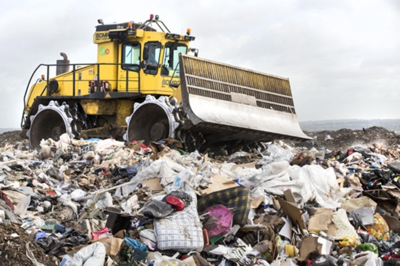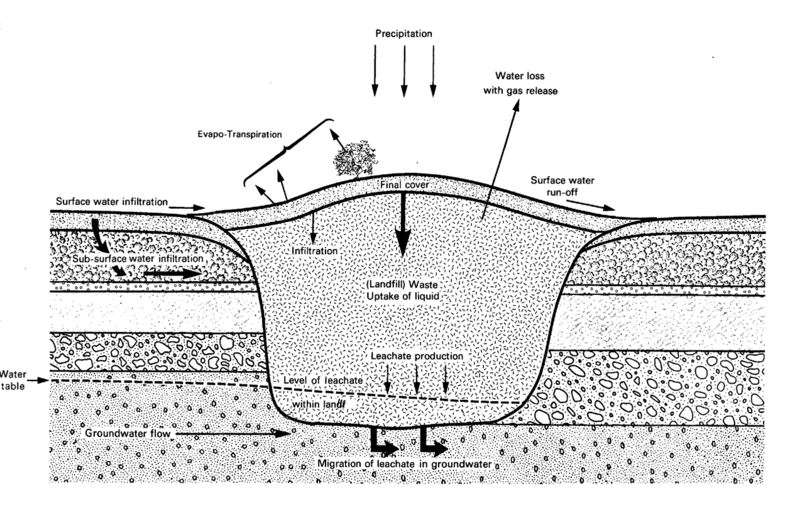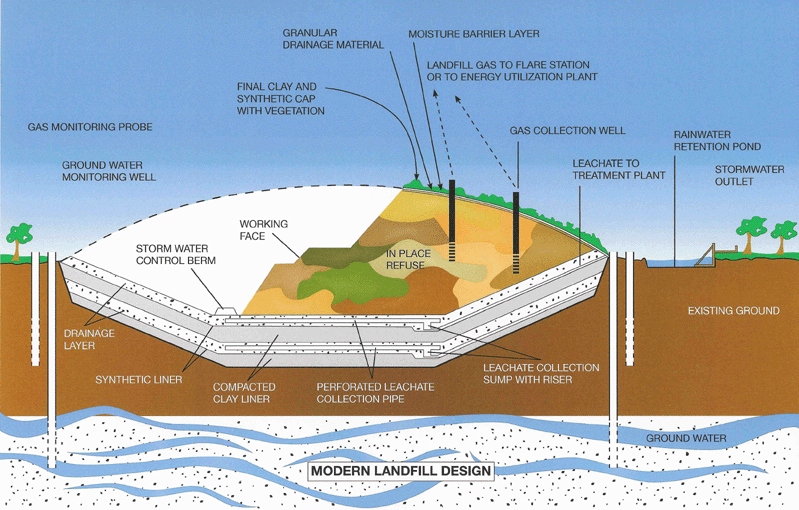Landfill
A Landfill Site is the ultimate destination for waste, ideally after all forms of Reuse, Recycling, and Recovery have been undertaken and as such it is at the bottom of the Waste Hierarchy.

Introduction
The Definition of 'Landfill' is found in the Landfill Directive 1999/31/EC on the landfilling of waste as 'a waste disposal site for the deposit of waste onto or into land (i.e.underground) including:
- internal waste disposal sites (i.e. landfill where a producer of waste is carrying out its own waste disposal at a place of production), and
- a permanent site (i.e. more than one year) which is used for temporary storage of waste'.
The deposit of waste into a Landfill site has evolved in the UK from 'open tips' and uncontrolled tipping in the late 1960's through to the current position comprising highly engineered solutions that contain and stabilize the waste in a 'Sanitary Landfill' - the complexity of the engineering approach and management being based upon the nature of the waste received and the sensitivity of the location of the site, especially in the context of the quality of the underlying groundwater.
Landfill sites have usually been constructed in disused quarries, or parts of quarries. However, the phrase is also used to describe sites built where there had previously been no excavation. Such sites are also known as “land-raise” sites, but in the context of this website, no distinction has been made. To all practical intents and purposes, there is no significant difference between landfill and land-raise.
Whilst Landfill is the ultimate destination for waste, ideally after all forms of Reuse, Recycling, and Recovery have been undertaken, there there will always be a small element of waste that will need to be landfilled in a safe and secure way (under the Landfill Directive no more than 10% of MSW generated by weight is to be landfilled by 2035). In developing countries, with limited infrastructure, the delivery of Sanitary Landfill would represent a huge step forwards in protecting water resources and human health.
The key legal requirements for managing landfill have been implemented in the UK through the Landfill Regulations 2005 which implemented the Landfill Directive and defined 3 types of Landfill:
and the standards are set out for the key stages of landfill in regards to:
- location
- engineering
- management
- closure and
- monitoring for landfills
Landfill Overview
The placement of waste in a landfill will slowly degrade over time, and in the case of the presence of Organic Waste within the Residual Waste going to landfill, it will breakdown to produce Landfill Gas and Leachate which have the potential to cause environmental pollution.
 |
 |
| Landfill Cross-Section of Older, Dilute and Disperse Style Landfill, no Engineering Containment | Cross-Section of Modern Engineered Landfill |
The 'go-to' guidance for many in the landfill sector in the UK is still the waste management papers produced in the mid and late 1990's:
- Waste Management Paper 26B (WMP26B): Landfill Design, Construction and Operational Practice
- Waste Management Paper 26A (WMP26A): Landfill Completion
- Waste Management Paper 27 (WMP27): Landfill Gas
Groundwater and Hydrogeology
One definition of aquifer is as follows, quoted from Freeze and Cherry (1979): “An aquifer is best described as a saturated permeable geologic unit that can transmit significant quantities of waste under ordinary hydraulic gradients”. This definition captures the essence of the word very well.
In the England and Wales, the EA categorize aquifers to be consistent with the Water Framework Directive. The categories are Principal Aquifer, Secondary Aquifer and Unproductive Strata. Previously the phrases major aquifer and minor aquifer were utilized. Similar arrangements exist in Scotland and are supervised by SEPA.
The relevance of the hydrogeological setting within which a landfill is located arises from the need to assess the technical precautions required for a landfill to be authorized such that unacceptable environmental impacts are prevented. This assessment is undertaken via a Hydrogeological Risk Assessment (HRA); this is submitted as supporting document to an Environmental Permit application. Again, similar arrangements are in place in Scotland.
Leachate
Putrescible waste placed in landfill sites undergoes decomposition. This is also described in WMP26B. The process gives rise to a liquid known as leachate. Leachate arises from water entering the waste matter, generally from rainfall on open areas of waste. Leachate is any liquid that, in the course of passing through matter, extracts soluble or suspended solids, or any other component of the material through which it has passed. Landfill leachate is strongly polluting in the external environment; one of the principal reasons for constructing landfill sites as containment facilities is to prevent landfill leachate from escaping from the waste mass in an uncontrolled manner.
Once the design of sites moved from dilute and disperse to containment designs, it became necessary to devise means of avoiding leachate from building up excessively within the waste mass. There are two drivers for this: (i) in extreme circumstances, the volumes could lead to levels over-topping the sides of any containment structures and leaving the site, and (ii) designing the site to maintain levels at a level as low as practically possible would improve the HRA outcome for any given design. Consequently, sites were designed with means to collect and remove leachate.
Leachate removed from the waste mass needs to be disposed of in an appropriate fashion. In general, this requires transmission to an appropriate treatment plant; this might be via a sewered connection to a sewage treatment plant operated by a utility company, or an on-site private leachate treatment plant. Depending upon the capacity at the receiving utility treatment plant, leachate may require pre-treatment at the landfill site.
A leachate treatment plant may discharge to a receiving watercourse or (less frequently) soakaway. Such a discharge would be regulated by the EA with an Environmental Permit. Discharge to a sewer, with or without pre-treatment, would require agreement with the relevant utility company.
Leachate may also be taken to an off-site facility (e.g utility sewage treatment works) via road-going tanker for disposal.
Landfill Engineering
Landfill engineering is a phrase used to describe the preparation and on-going engineering required to operate a landfill site.
What is required at any particular site depends upon the proposals made by the permit holder in order to be granted an Environmental Permit and any subsequent modifications agreed between the permit holder and the regulator (EA, NRW or SEPA).
The technical precautions required to operate a landfill are incorporated into the landfill engineering design. Notwithstanding that, there are minimum requirements imposed by the Landfill Directive and subsequent UK legislation – The Landfill (England and Wales) Regulations 2002 and the Landfill Regulations 2005.
The design will have been produced taking heed of the technical precautions required to satisfy the regulator that the site will not have an unacceptable impact upon the environment and that the approved design will comply with the requirements of the Landfill Directive. These precautions will have been validated against the various risk assessments required to accompany a permit application.
Usually the application will be accompanied by risk assessments of the hydrogeological impact of the site, the potential for landfill gas release and the stability of any engineering designs proposed. There will be additional risk assessments required for operational matters such as dust, noise and amenity impacts; these are largely managed by operational techniques, but occasionally there will be elements of mitigation required that constitute site engineering (e.g. the construction of noise bunds).
Sites which were authorised historically did not require engineering and such sites without an engineered lining system are commonly described as “dilute and disperse”. Notwithstanding the lack of site engineering, some evaluation of their pollution potential was undertaken. This mainly consisted of a simple evaluation of the ability of the surrounding geology to adsorb contamination to determine likely consequential pollution effects. This evaluation considered the ability of the ground to “dilute and disperse” the impact of the site, hence the common name.
Landfill engineering design evolved in the 1980s, such that new dilute and disperse sites became less likely to be granted consent to operate. At the time, this was not supported by the implementation of any new specific legislative drivers, the principal legislation remaining the Control of Pollution Act 1974. This required landfills to be licensed by local authorities. In assessing licence applications, local authorities were required to ensure the prevention of pollution to water and danger to public health. This requirement established a rationale for assessment and its implementation evolved over the period from 1976 onwards.
Landfill sites that incorporate engineered barriers are known as “containment facilities”. The design of such facilities has more than one form and can incorporate different numbers of layers and different designs. These layers are conventionally known as the “landfill lining system”.
The Department of the Environment produced a series of Waste Management Papers (WMP) over the period from the late 1970s to 1997. WMP 26B contains a review of the types of designs. The design employed at any particular design would be informed by the outcome of the HRA which would assess the likely impact of a site upon the environment taking account of the design proposed. In general terms, the most sensitive sites would require the greatest degree of engineering.
Landfills are constructed in discrete parts known as “landfill cells”. The sub-division into cells is undertaken so as to minimise the operating area and consequently minimise leachate generation and make the site more manageable in terms of odour and litter control. Sub-division also enables the site engineering to be constructed progressively as the site fills.
Landfill Gas
Another product of waste decomposition is landfill gas. This is a mixture of various components, principally methane. WMP26B also contains a useful review of the generation and evolution of landfill gas.
Landfill gas needs to be managed to prevent build-up, migration in the surrounding soils and rock and release to the atmosphere.
Management of landfill gas consists of prevention of migration and escape by containment barrier, active removal of the gas from the waste mass by extraction and subsequent destruction.
Landfill gas can be utilized for energy generation – principally electricity generation – as well as simple destruction by combustion in a flare.
WMP27 deals with methods for management of landfill gas.
Electricity generated from landfill gas can be used on-site and also be supplied to the National Grid for re-sale.
Landfills in the UK
Set out the criteria for location - geology, hydrogeology, historical context
Set out the sites in the UK and the location map of sites in the UK here?
